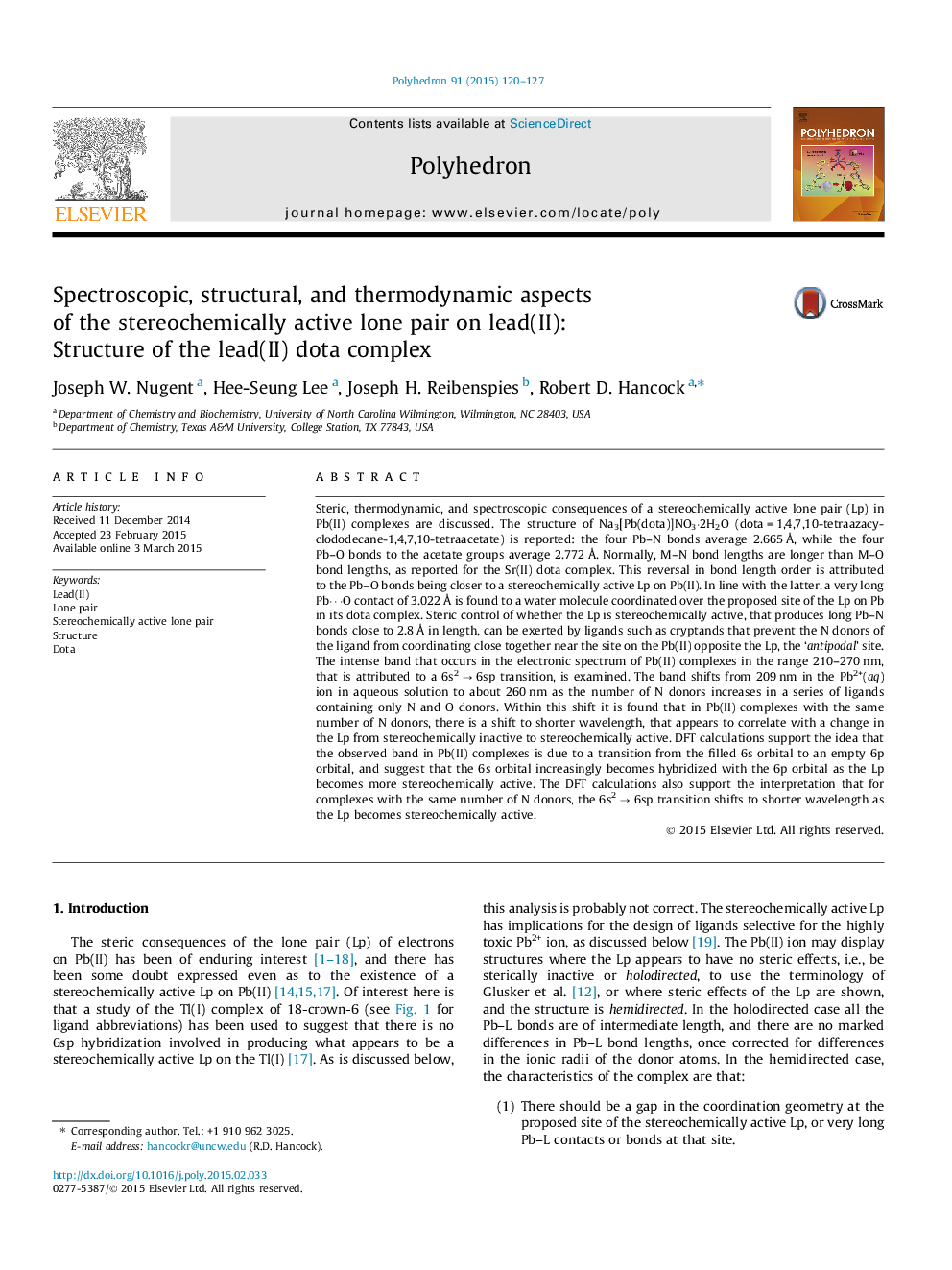| کد مقاله | کد نشریه | سال انتشار | مقاله انگلیسی | نسخه تمام متن |
|---|---|---|---|---|
| 1335235 | 1500248 | 2015 | 8 صفحه PDF | دانلود رایگان |

Steric, thermodynamic, and spectroscopic consequences of a stereochemically active lone pair (Lp) in Pb(II) complexes are discussed. The structure of Na3[Pb(dota)]NO3·2H2O (dota = 1,4,7,10-tetraazacyclododecane-1,4,7,10-tetraacetate) is reported: the four Pb–N bonds average 2.665 Å, while the four Pb–O bonds to the acetate groups average 2.772 Å. Normally, M–N bond lengths are longer than M–O bond lengths, as reported for the Sr(II) dota complex. This reversal in bond length order is attributed to the Pb–O bonds being closer to a stereochemically active Lp on Pb(II). In line with the latter, a very long Pb⋯O contact of 3.022 Å is found to a water molecule coordinated over the proposed site of the Lp on Pb in its dota complex. Steric control of whether the Lp is stereochemically active, that produces long Pb–N bonds close to 2.8 Å in length, can be exerted by ligands such as cryptands that prevent the N donors of the ligand from coordinating close together near the site on the Pb(II) opposite the Lp, the ‘antipodal’ site. The intense band that occurs in the electronic spectrum of Pb(II) complexes in the range 210–270 nm, that is attributed to a 6s2 → 6sp transition, is examined. The band shifts from 209 nm in the Pb2+(aq) ion in aqueous solution to about 260 nm as the number of N donors increases in a series of ligands containing only N and O donors. Within this shift it is found that in Pb(II) complexes with the same number of N donors, there is a shift to shorter wavelength, that appears to correlate with a change in the Lp from stereochemically inactive to stereochemically active. DFT calculations support the idea that the observed band in Pb(II) complexes is due to a transition from the filled 6s orbital to an empty 6p orbital, and suggest that the 6s orbital increasingly becomes hybridized with the 6p orbital as the Lp becomes more stereochemically active. The DFT calculations also support the interpretation that for complexes with the same number of N donors, the 6s2 → 6sp transition shifts to shorter wavelength as the Lp becomes stereochemically active.
The structure of Na3[Pb(dota)]NO3·2H2O (dota = 1,4,7,10-tetraazacyclododecane-1,4,7,10-tetraacetate) is reported: the four Pb–N bonds are shorter than the four Pb–O bonds, and a long Pb⋯O contact of 3.022 Å is found to a H2O molecule over the site of the Lp (lone pair) on Pb, features associated with a stereochemically active Lp. The 6s2 → 6sp transition in the electronic spectrum of Pb(II) complexes shows shifts dependent on the number of N donors, and whether the Lp is stereochemically active. DFT calculations suggest that the 6s orbital becomes more hybridized with the lowest energy 6p orbital, and that the 6s2 → 6sp transition shifts to shorter wavelength, as the Lp becomes more stereochemically active.Figure optionsDownload as PowerPoint slide
Journal: Polyhedron - Volume 91, 8 May 2015, Pages 120–127